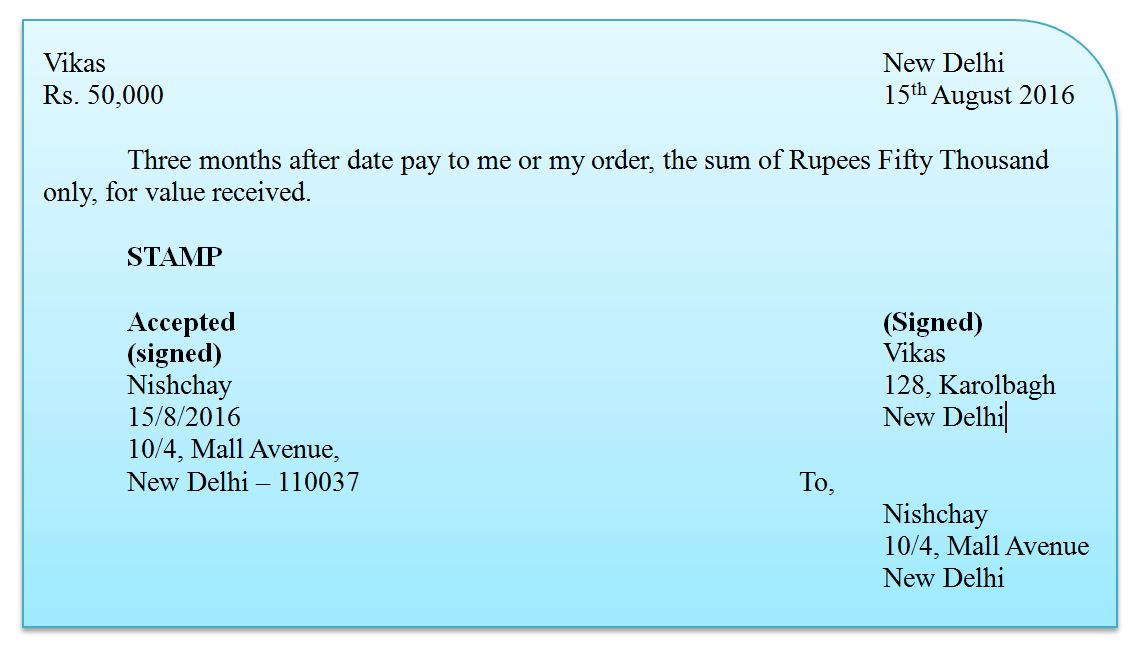A bill is a negotiable money market instrument used to finance trade related transactions.
According to the Indian Negotiable Instruments Act, 1881, “It is an instrument in writing containing an unconditional order, signed by the maker of the bill, directing a certain person to pay a certain sum of money only to, or to the order of, a certain person, or to the bearer of that instrument.”
Bills of Exchange are used for financing a transaction in goods therefore they are essentially trade-related instruments. The holder of a bill can either hold on to a bill till its maturity or discount the endorsed bill with a discounting agency to obtain cash. The difference between in between the face value of a bill and the actual money received by a seller is called a discount.
Essentials of Bills of Exchange –
- It must be in writing.
- It must contain an unconditional order to pay
- The parties and the sum payable must be certain
- It must be signed by the drawer
- It must comply with all other formalities like stamp, date, place, consideration etc.
Specimen of bills of exchange

Parties involved in Bills of Exchange
Essentially there are three parties involved; the Drawer, the Drawee and the Payee.
- Drawer – The person who draws the bill.
- Drawee – The person on whom the bill is drawn.
- Payee – The one who pays. It may be the drawee or someone on his behalf.
Other parties may also become the part of the bill after it is drawn. Few terms you should be familiar with are:
- Acceptor – The person who accepts the bill. It may be the drawee or someone on behalf of the drawee.
- Holder – The person on whom the bill is endorsed. It may be the payee or the bearer of the bill.
- Endorser – If the holder of the bill endorses it to someone else, he becomes the endorser.
- Endorsee – The person to whom the bill is endorsed.
Drawee in case of need – A person may be introduced at the option of the drawee as a last resort, in case the bill is dishonoured by non-acceptance or non-payment.
Acceptor for Honour – When a person voluntarily accepts the bill and becomes a party to it in order to safeguard the honour of the drawee or any other endorser, he becomes the acceptor for honour.
Types of Bills of exchange
(1) Demand Bill – A bill of exchange that is payable on demand or at sight or when presented is a demand bill. In a demand bill the time of payment and due date is not specified and hence it can made payable on presentment.
(2) Usance Bill – A bill which specifies the time period for the payment is a usance bill. It is also known as a time bill.
(3) Documentary bills – It is a bill which is accompanied by documents confirming genuineness of trade transaction that took place between the buyer and seller. These documents include invoices, railway receipts, lorry receipts, bills of ladding etc. They may be further classified into :
- D/A (Documents against acceptance) Bills – If the documents are delivered to the drawee against acceptance of a bill, it is a D/A bill. The bill become a clean bill after delivery of documents
- D/P (Documents against payment) Bills – If the documents are delivered to drawee against payment of the bill, it is a D/P bill. After delivery the documents are held by drawee’s banker till the maturity of the bill.
(4) Clean bills – A clean bill does not accompany any documents of proof. The interest rate charged on clean bills is usually higher than documentary bills
(5) Inland Bills – It is a bill of exchange that is drawn in India and payable in India or a bill drawn on an Indian resident, either payable in India or any other country.
(6) Foreign bills – All bills of exchange payable outside India are foreign bills. Bills which are not inland bills are foreign bills.
- Export bill – A bill drawn by an exporter on party outside India
- Import bill – A bill drawn by exporter outside India on Indian importers.
(7) Trade Bill – A bill drawn and accepted for the purpose of a genuine trade transaction.
(8) Accommodation bills – A bill drawn, accepted or endorsed without any consideration is called an accommodation bill.
(9) Fictitious bill – A bill in which the name of the drawee or payee or both is fictitious is a fictitious bill.
(10) Hundis – These are indigenous bills of exchange and promissory notes that are usually used for financing agriculture and inland trade.
(11) Supply bills – A bill drawn by a supplier or contractor on a government department for supplies made to them is a supply bill. It is drawn to obtain cash advances from financial institutions to meet financial needs due to pending payment from government departments. These bills are not accepted by government department but are eligible for obtaining cash loans from commercial banks due to its non-negotiable characteristic.
Bills in Sets
When a bill drawn in parts in order to avoid losing the bill in transit and to ensure that at least one part of the bill reaches the drawee, it is known as bills in set. A bill may be drawn in two, three or four parts and all the parts together make one bill, each part of the bill is known as a ‘via’ and as soon as one part of the bill is accepted the other parts become ineffective. It usually takes place in case of cross-border transactions.